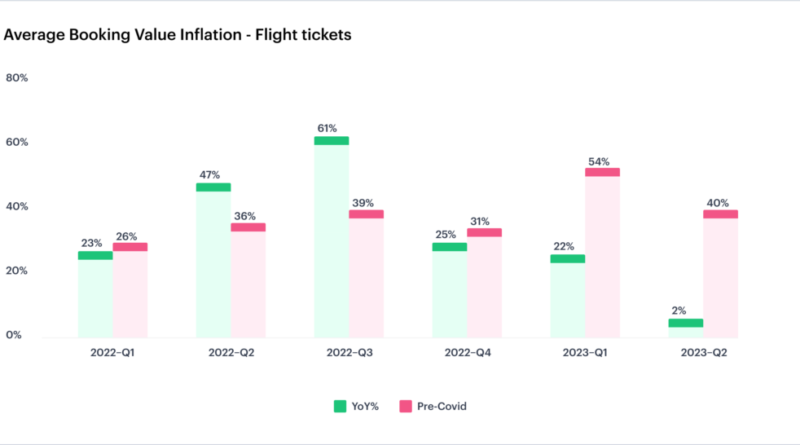Is inflation still impacting business travel prices? Key takeaways from our latest H1 2023 inflation report.
For many business travelers, 2022 was a challenging year with numerous flight cancellations, travel disruptions, and the cost of living crisis causing a significant impact on business travel costs.
For any business, managing limited budgets without compromising profit and productivity is always a priority. With our 2022 inflation report indicating that travel prices would continue to increase, we wanted to find out exactly how business travel costs have been impacted so far this year.
Has inflation continued to have a big impact on the cost of business travel so far in 2023?
Are there differences in travel pricing trends in the US, UK and Europe?
Which travel verticals are recovering quicker post-pandemic?
To get the answers to these questions and more, we analyzed booking data from our industry-leading corporate travel inventory and global customer base. We compared pre-COVID data (2019) to comparable quarter periods in 2022-2023 (post-COVID) and analyzed price trends based on average booking value across different travel verticals such as airfares, hotels, and rail.
Here’s what we found out…
Key findings on business travel prices in the first half of 2023
- Airfares and hotel rates are showing stabilization in the second quarter (Q2) of 2023, with average price increases trending significantly lower than the same period in 2022.
- After a +47% increase year over year (YoY) in Q2 2022 based on average customer booking value, airfares for flights departing the US, UK and Europe began to normalize in Q2 2023 (+2% YoY).
- Since peaking in Q2 2022, the average cost of US airfares has remained virtually constant between Q3 2022 through to Q1 2023. In Q2 2023, the price of flights departing the US increased by only +1% YoY, much less than the European (including UK) average (+9% YoY).
- Incentives in various European countries, including Spain, may be driving train ticket prices down below pre-pandemic levels. Compared to the same period in 2019, in Q1 and Q2 2023, train prices dropped -23% and -15% respectively.
- Hotel prices see a more settled inflation trend in Q2 2023, with only a +4% increase in hotel booking daily rates compared to +59% in the same quarter the previous year.
Travel inflation: Factors influencing price changes in the US & Europe
Let’s start by looking at the variety of factors that affect price fluctuations for flights, hotels and trains. Our analysis shows the percentage change year over year – and in comparison to pre-pandemic levels in 2019, based on the average booking spend for each vertical.
Although prices continue to trend upwards overall, the increase year over year isn’t as sharp as the average booking inflation levels seen in 2022. There are a number of explanations for the increases in price for travel:
- Pent-up demand post-COVID for business and leisure travel. This increased appetite for travel had a direct impact on the cost of transport and accommodation.
- Energy price inflation resulting from the war in Ukraine.
- Numerous strikes, cancellations, and travel disruptions in the Summer and Fall of 2022 which subsequently caused prices to increase.
The Global Business Travel Association predicts that business travel is set to recover to its pre-pandemic total of $1.4 billion by 2024 – two years earlier than originally forecasted. According to their report, this is due to “more favorable economic conditions”.
A closer look: Business travel prices by vertical and region
Let’s dig into how prices have evolved across flights, hotels, and trains.
How flight prices are shifting in the UK, US, and Europe
In H1 2023, we see overall flight prices stabilize significantly. In Q2 2023, prices increased by just +2% compared to the same period the previous year. This is a significant decrease compared to the +47% increase in flight prices in Q2 2022, a period that was affected by travel chaos.
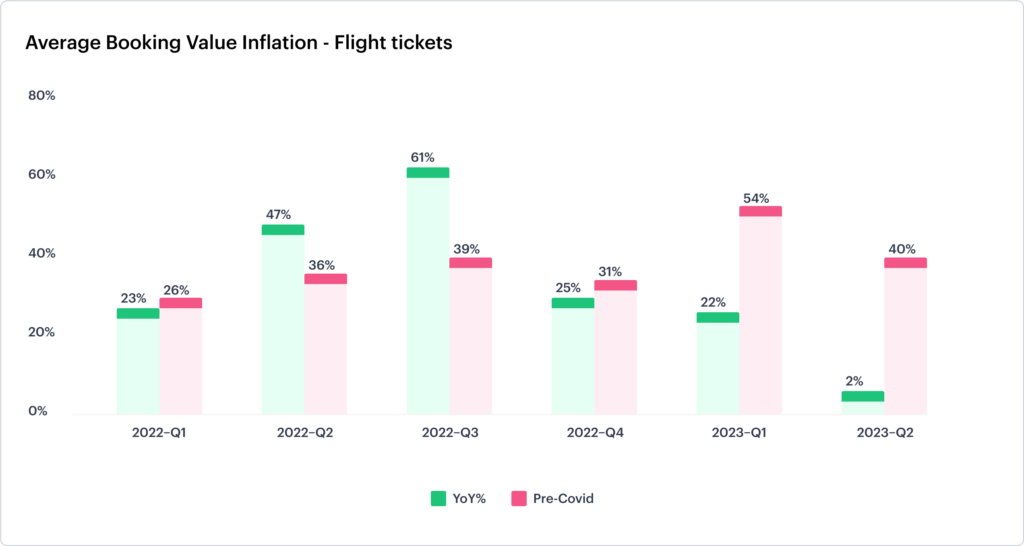
We see the biggest impact on flight price increases in Q3 2022 (+61% YoY), but this begins to stabilize quarter over quarter as we move into the first half of 2023.
No more turbulence – Flight prices stabilize in the U.S.
Looking at both domestic and international flights departing the US, airfare prices experienced the sharpest YoY peak in Q2 2022 with a +57% increase.
Since then, our data shows that prices have been holding steady, with the second quarter of 2023 resulting in a small +1% increase in price YoY. The US tapped into strategic fuel reserves to combat global energy inflation. As a result, as shown by data from the OECD, we see the US energy inflation curve as a smaller peak compared to Europe.
What’s even more interesting to note in the graph below is the steady average US flight price of around €480 (~$520) throughout Q3 2022 until Q1 2023, despite fluctuating energy costs at that time.
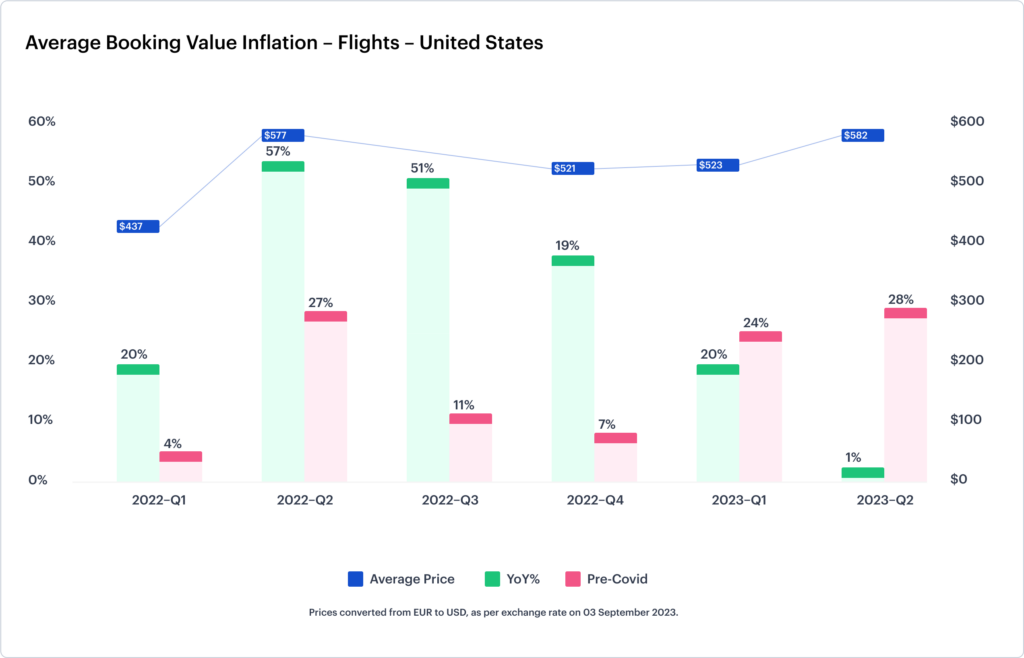
The view from the other side of the Atlantic
In Europe, the picture looks slightly different to the US . The peak in prices in this region came in Q3 2022 (+69% YoY) compared to Q2 2022 (+57%) in the US.
Flight price inflation continues to affect markets in Europe more than the US due to the greater impact of the Ukraine war in this region. European (including UK) airline ticket prices departing this region in Q2 2023 are trending +9% higher YoY, eight percentage points more than the US for the same period. The UK, France, and the Netherlands experienced the longtail of energy inflation, with the biggest spikes in those markets recorded in Q3 2022. In that same quarter, the UK and France saw YoY prices skyrocket at +125% and +110%, respectively.
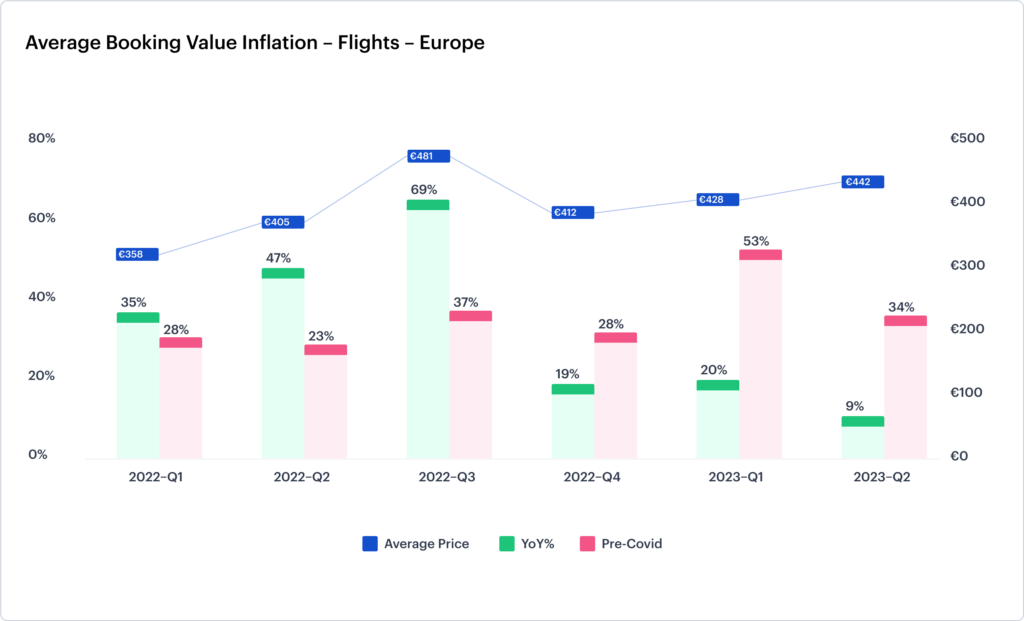
It’s worth mentioning the European flight inflation of +69% in Q3 2022 is the highest increase in YoY prices for this segment, compared to other travel verticals and regions.
Checking in: The top trends in hotel rates
Hotel rate trends have seen a steady YoY increase of over +40% from Q1 to Q3 2022. The lowering of COVID travel restrictions increased the appetite for business and leisure travel, which resulted in a price increase of almost +60% in Q2 2022 compared to the same period the previous year, peaking at an average daily rate of €159 (~$171) in Q3 2022.
However, so far in the first half of 2023, we see a more settled inflation trend, with pre-COVID inflation plateauing at around +19% (H1 2023) and YoY inflation showing as low as +4% in Q2 of 2023. This trend is likely due to the stabilized demand for business trips compared to previous years. The increased demand for travel in Q2 2023 from fewer Covid restrictions regionally is beginning to increase prices up again to €155 (~$166).
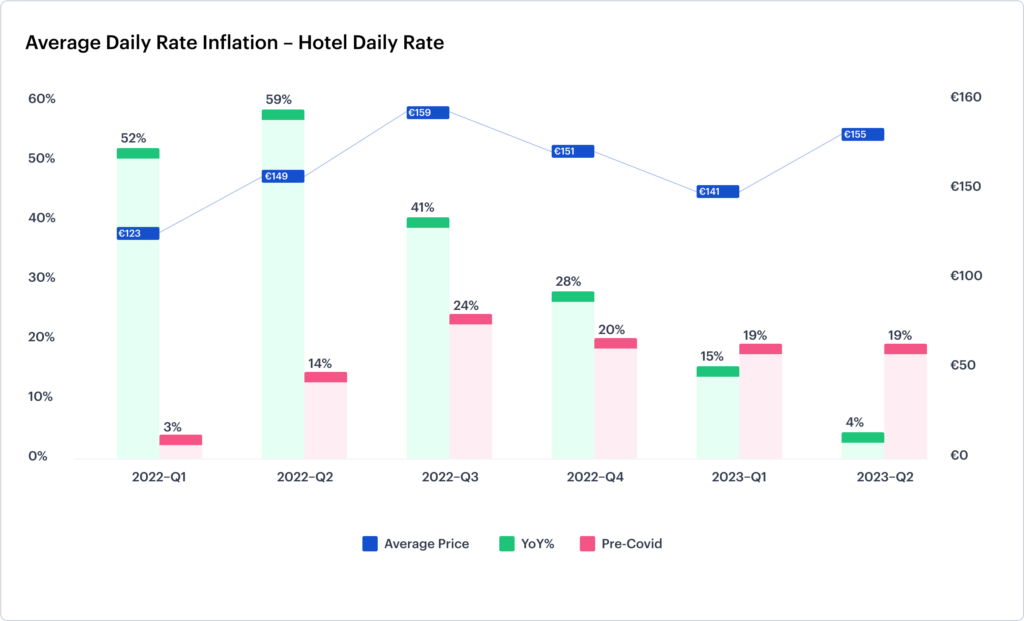
Railway rewards – train prices drop in the first half of 2023
Train ticket prices showed some stabilization in Q2 2023 (+5% YoY), compared to the same quarter in 2022 (+11% YoY).
Train travel incentives could be one factor contributing to the price decrease; Spain and Germany introduced these to reduce the impact of the cost of living crisis and encourage more sustainable travel habits. However, it’s important to note that there are many external factors that impact train pricing, including supply and demand.
Compared to pre-pandemic, in Q1 and Q2 2023, global train prices have dropped -23% and -15% respectively. Some notable cost decreases recorded in H1 2023 versus H1 2019 are for rail services in France (-47%), the UK (-46%) and Spain (-34%).
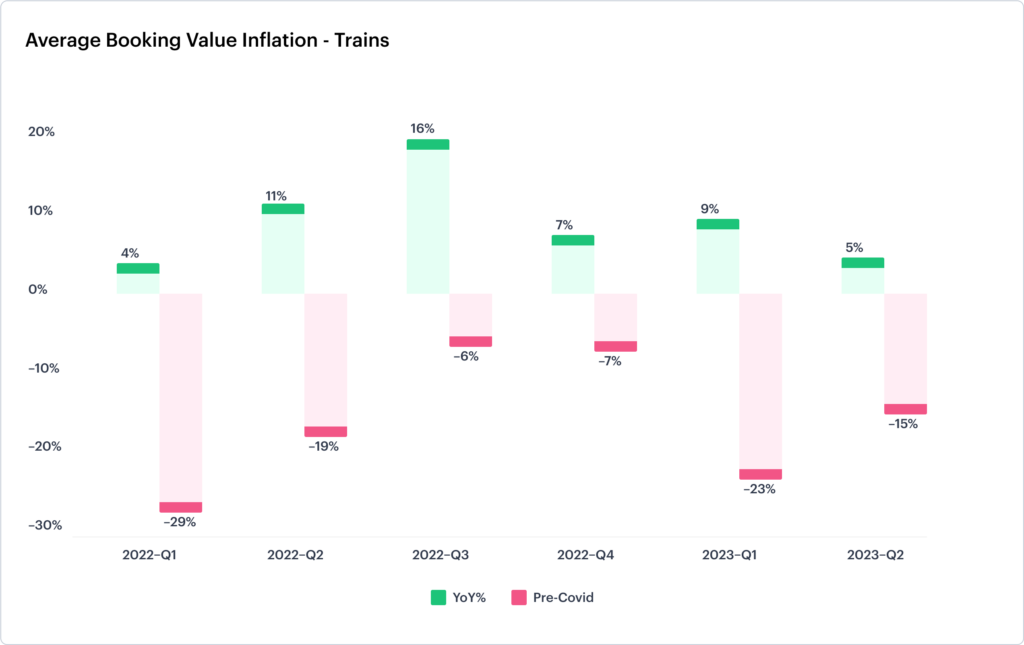
3 top tips to help beat inflation for business travelers
- Be flexible with travel options – The impact of inflation isn’t the same in every region, as demonstrated in our report. So, business travel managers should consider more budget-friendly routes and destinations that are less impacted by rising costs. Do you really need to host your team offsite in London? Or could you save on travel expenses by choosing another city in Europe? You could make significant savings to the overall cost of your business travel by being more flexible with destinations. Rail prices have increased less than flights, so consider taking the train if you have the option. It could be a smarter choice both for your budget and the environment!
- Book in advance – Our data shows that business travelers continue to book international trips and domestic trips much closer to their departure date than they were pre-pandemic. The biggest savings are often found the more you book ahead (especially with airfares). With much of the chaos and uncertainty behind us, there is a significant economic benefit to booking early. Plus, with flexible travel options like FlexiPerk, should your plans change, you can cancel up to 2 hours before departure and get 80% of the cost of your trip back, no questions asked.
- Make the most of exclusive negotiated rates – Business travel management software like TravelPerk uses the combined buying power of their customers to negotiate exclusive rates on accommodation and travel and pass these savings on to their customers. In fact, there are over 26,000 exclusive hotel rates to choose from with savings up to 25% when you book with TravelPerk. With its industry-leading inventory, TravelPerk makes business travel more affordable and a lot simpler to manage.
Start saving money on business travel for your company today!
Report Methodology
TravelPerk analyzed booking data from its customers between 2019 (pre-COVID) and compared it to data from 2022-2023 (post-COVID). Travel verticals within this report include flights, hotels and trains.
European (UK) and US flight graphs show both domestic and international flights departing these countries/regions.
European (UK) and US hotel and train graphs show trips and stays within these countries/regions only.
YoY % = % difference of the current Q vs the same Q in the previous year
Precovid = % difference of the current Q vs the same Q in 2019
Price conversion: EU to USD and GBP as per currency rates on 03 September 2023.

